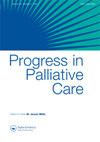患者在癌症中心转诊时获得住院与门诊姑息治疗的差异
IF 0.8
Q4 PUBLIC, ENVIRONMENTAL & OCCUPATIONAL HEALTH
引用次数: 0
摘要
门诊姑息治疗诊所是一个新的、不断发展的服务提供领域,可以应对日益增长的需求,并促进疾病轨迹中的早期接触。需要努力标准化转诊到门诊姑息治疗服务的标准,并澄清哪些患者可能从这种支持模式中受益最大。本研究旨在描述新建立的以医院为基础的综合姑息治疗项目患者的人口统计学、临床和症状特征以及生存率。将最初被视为门诊患者的患者与被视为住院患者的患者进行比较。从常规收集的住院患者和流动数据库中确定了一个回顾性人群,包括在6个月内接受新转诊的成年癌症患者。根据首次姑息治疗评估的设置,患者被分为两组,并随访至死亡或研究审查日期。在研究期间,473名新的转诊患者被转诊,其中229名(48%)患者最初被视为门诊患者,244名(52%)患者最初为住院患者。门诊队列的表现状态更高,症状负担更高,寿命更长,住院人数更少,并且更早地接受姑息治疗转诊,导致更多的姑息治疗参与,直到死亡(所有p < .05)。早期姑息治疗可以通过门诊姑息治疗服务有效地为癌症患者提供,这些患者正在经历症状负担,但在其他方面功能正常。这些病例的寿命更长,随后的住院就诊次数更少,这表明了这种综合服务的初步有效性。本文章由计算机程序翻译,如有差异,请以英文原文为准。
Differences in patients accessing inpatient versus outpatient palliative care at time of referral at a cancer centre
Outpatient palliative care clinics are a new and developing area of service delivery that can respond to increasing demand and facilitate earlier contact in the illness trajectory. Work is needed to standardise the criteria for referral to outpatient palliative care services and clarify which patients are likely to benefit the most from this mode of support. This study aimed to describe the demographic, clinical and symptom profile, and survival of patients referred to a newly established hospital-based integrated palliative care program. Comparisons were made between patients initially seen as outpatients versus those seen as inpatients. A retrospective population was identified from routinely collected hospital admitted inpatient and ambulatory databases comprising adult cancer patients receiving a new referral to the service during a 6-month period. Patients were grouped into two cohorts according to the setting of their first palliative care assessment and followed to death or study censor date. During the study period, 473 new referrals were made comprising 229 (48%) patients initially seen as outpatients and 244 (52%) initially seen as inpatients. The outpatient cohort had higher performance status, experienced higher symptom burden, lived longer, had fewer inpatient admissions, and received earlier referral to palliative care resulting in greater palliative care involvement up to their death (all p < .05). Early palliative care can be effectively delivered by an outpatient palliative care service for cancer patients who are experiencing symptom burden but are otherwise functional. These cases lived longer and had fewer subsequent inpatient visits, demonstrating the preliminary effectiveness of this integrated service.
求助全文
通过发布文献求助,成功后即可免费获取论文全文。
去求助
来源期刊

PROGRESS IN PALLIATIVE CARE
PUBLIC, ENVIRONMENTAL & OCCUPATIONAL HEALTH-
CiteScore
2.60
自引率
11.80%
发文量
24
期刊介绍:
Progress in Palliative Care is a peer reviewed, multidisciplinary journal with an international perspective. It provides a central point of reference for all members of the palliative care community: medical consultants, nurses, hospital support teams, home care teams, hospice directors and administrators, pain centre staff, social workers, chaplains, counsellors, information staff, paramedical staff and self-help groups. The emphasis of the journal is on the rapid exchange of information amongst those working in palliative care. Progress in Palliative Care embraces all aspects of the management of the problems of end-stage disease.
 求助内容:
求助内容: 应助结果提醒方式:
应助结果提醒方式:


